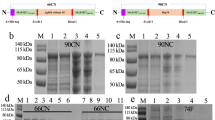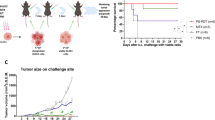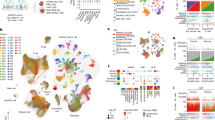Abstract
Adjuvants for vaccines with characteristics of improving adaptive immunity particularly via leverage of antigen presenting cells (APCs) are currently lacking. In a previous work we obtained a new soluble 300 kDa homogeneous β-glucan named GFPBW1 from the fruit bodies of Granola frondosa. GFPBW1 could activate macrophages by targeting dendritic cell associated C-type lectin 1 (Dectin-1)/Syk/NF-κB signaling to achieve antitumour effects. In this study the adjuvant effects of GFPBW1 were explored with OVA-antigen and B16-OVA tumor model. We showed that GFPBW1 (5, 50, 500 μg/mL) dose-dependently promoted activation and maturation of APCs in vitro by increasing CD80, CD86 and MHC II expression. We immunized female mice with OVA in combination with GFPBW1 (50 or 300 μg) twice with an interval of two weeks. GFPBW1 markedly and dose-dependently increased OVA-specific antibody titers of different subtypes including IgG1, IgG2a, IgG2b and IgG3, suggesting that it could serve as an adjuvant for both Th1 and Th2 type immune responses. Furthermore, GFPBW1 in combination with aluminum significantly increased the titers of OVA-specific IgG2a and IgG2b, but not those of IgG1, suggesting that GFPBW1 could be used as a co-adjuvant of aluminum to compensate for Th1 deficiency. For mice immunized with OVA plus GFPBW1, no obvious pathological injury was observed in either major organs or injection sites, and no abnormalities were noted for any of the hematological parameters. When GFPBW1 served as an adjuvant in the B16-OVA cancer vaccine models, it could accomplish entire tumor suppression with preventive vaccines, and enhance antitumour efficacy with therapeutic vaccines. Differentially expressed genes were found to be enriched in antigen processing process, specifically increased tumor infiltration of DCs, B1 cells and plasma cells in the OVA plus GFPBW1 group, in accordance with its activation and maturation function of APCs. Collectively, this study systematically describes the properties of GFPBW1 as a novel potent and safe adjuvant and highlights its great potential in vaccine development.

This is a preview of subscription content, access via your institution
Access options
Subscribe to this journal
Receive 12 print issues and online access
$259.00 per year
only $21.58 per issue
Buy this article
- Purchase on SpringerLink
- Instant access to full article PDF
Prices may be subject to local taxes which are calculated during checkout







Similar content being viewed by others
Data availability
All data are available in the main text, the Supporting Information materials, or upon request from the corresponding author. Correspondence and requests for materials should be addressed to YFY, LKG, JHS, and KD.
References
Saxena M, van der Burg SH, Melief CJM, Bhardwaj N. Therapeutic cancer vaccines. Nat Rev Cancer. 2021;21:360–78.
Lin MJ, Svensson-Arvelund J, Lubitz GS, Marabelle A, Melero I, Brown BD, et al. Cancer vaccines: the next immunotherapy frontier. Nat Cancer. 2022;3:911–26.
Qi F, Zhao L, Zhou A, Zhang B, Li A, Wang Z, et al. The advantages of using traditional Chinese medicine as an adjunctive therapy in the whole course of cancer treatment instead of only terminal stage of cancer. Biosci Trends. 2015;9:16–34.
Zhang Y, Gu P, Wusiman A, Xu S, Ni H, Qiu T, et al. The immunoenhancement effects of polyethylenimine-modified Chinese Yam polysaccharide-encapsulated PLGA nanoparticles as an adjuvant. Int J Nanomed. 2020;15:5527–43.
Wang QJ, Meng XY, Zhu L, Xu YL, Cui WP, He XH, et al. A polysaccharide found in flowers can enhance cellular and humoral immunity in chickens. Int J Biol Macromol. 2019;130:213–9.
Wang YQ, Mao JB, Zhou MQ, Jin YW, Lou CH, Dong Y, et al. Polysaccharide from activates TLR4-mediated signaling pathways in macrophages and shows immune adjuvant activity in mice. Int J Biol Macromol. 2019;123:157–66.
Feng HB, Fan J, Song ZH, Du XG, Chen Y, Wang JS, et al. Characterization and immunoenhancement activities of polysaccharides. Carbohydr Polym. 2016;136:803–11.
Hwang SH, Shin MS, Yoon TJ, Shin KS. Immunoadjuvant activity in mice of polysaccharides isolated from the leaves of CA Meyer. Int J Biol Macromol. 2018;107:2695–700.
Liu X, Chen S, Liu H, Xie J, Hasan KMF, Zeng Q, et al. Structural properties and anti-inflammatory activity of purified polysaccharides from Hen-of-the-woods mushrooms (Grifola frondosa). Front Nutr. 2023;10:1078868.
Fang J, Wang Y, Lv X, Shen X, Ni X, Ding K. Structure of a β-glucan from Grifola frondosa and its antitumor effect by activating Dectin-1/Syk/NF-κB signaling. Glycoconj J. 2012;29:365–77.
Taylor PR, Tsoni SV, Willment JA, Dennehy KM, Rosas M, Findon H, et al. Dectin-1 is required for β-glucan recognition and control of fungal infection. Nat Immunol. 2007;8:31–8.
Brown GD, Taylor PR, Reid DM, Willment JA, Williams DL, Martinez-Pomares L, et al. Dectin-1 is a major beta-glucan receptor on macrophages. J Exp Med. 2002;196:407–12.
Mata-Martínez P, Bergón-Gutiérrez M, del Fresno C. Dectin-1 signaling update: new perspectives for trained immunity. Front Immunol. 2022;13:812148.
Carvalho A, Giovannini G, De Luca A, D’Angelo C, Casagrande A, Iannitti RG, et al. Dectin-1 isoforms contribute to distinct Th1/Th17 cell activation in mucosal candidiasis. Cell Mol Immunol. 2012;9:276–86.
Leibundgut-Landmann S, Osorio F, Brown GD, Reis e Sousa C. Stimulation of dendritic cells via the dectin-1/Syk pathway allows priming of cytotoxic T-cell responses. Blood. 2008;112:4971–80.
Yu X, Long Y, Chen B, Tong Y, Shan M, Jia X, et al. PD-L1/TLR7 dual-targeting nanobody-drug conjugate mediates potent tumor regression via elevating tumor immunogenicity in a host-expressed PD-L1 bias-dependent way. J Immunother Cancer. 2022;10:e004590.
Sun B, Yu S, Zhao D, Guo S, Wang X, Zhao K. Polysaccharides as vaccine adjuvants. Vaccine. 2018;36:5226–34.
Abbas AK, Murphy KM, Sher A. Functional diversity of helper T lymphocytes. Nature. 1996;383:787–93.
Romagnani S. Th1/Th2 cells. Inflamm Bowel Dis. 1999;5:285–94.
Wan X, Yin Y, Zhou C, Hou L, Cui Q, Zhang X, et al. Polysaccharides derived from Chinese medicinal herbs: A promising choice of vaccine adjuvants. Carbohydr Polym. 2022;276:118739.
Hogenesch H. Mechanism of immunopotentiation and safety of aluminum adjuvants. Front Immunol. 2012;3:406.
Zhang J, Chen Y, Zhang J, Wang Y, Liu Y. The Regulation of micro-organisms’ extra-cellular polysaccharides on immunity: a meta-analysis. Foods. 2022;11:1949.
Yang K, Chen J, Chen J, Wang Z, Song B, Li R, et al. The effect mechanism of polysaccharides inhibit tumor immune escape: A review. J Funct Foods. 2023;107:105638.
Kikete S, Luo L, Jia B, Wang L, Ondieki G, Bian Y. Plant-derived polysaccharides activate dendritic cell-based anti-cancer immunity. Cytotechnology. 2018;70:1097–110.
Zhang W, Zheng X, Cheng N, Gai W, Xue X, Wang Y, et al. Isatis indigotica root polysaccharides as adjuvants for an inactivated rabies virus vaccine. Int J Biol Macromolecules. 2016;87:7–15.
Broaders KE, Cohen JA, Beaudette TT, Bachelder EM, Fréchet JM. Acetalated dextran is a chemically and biologically tunable material for particulate immunotherapy. Proc Natl Acad Sci USA. 2009;106:5497–502.
Chen N, Gallovic MD, Tiet P, Ting JP, Ainslie KM, Bachelder EM. Investigation of tunable acetalated dextran microparticle platform to optimize M2e-based influenza vaccine efficacy. J Controlled Rel. 2018;289:114–24.
Brown GD, Gordon S. Fungal beta-glucans and mammalian immunity. Immunity. 2003;19:311–5.
Sahasrabudhe NM, Dokter-Fokkens J, de Vos P. Particulate beta-glucans synergistically activate TLR4 and Dectin-1 in human dendritic cells. Mol Nutr Food Res. 2016;60:2514–22.
Li N, Zhang Y, Han M, Liu T, Wu J, Xiong Y, et al. Self-adjuvant Astragalus polysaccharide-based nanovaccines for enhanced tumor immunotherapy: a novel delivery system candidate for tumor vaccines. Sci China Life Sci. 2024;67:680–97.
Buonaguro L, Cavalluzzo B, Mauriello A, Ragone C, Tornesello AL, Buonaguro FM, et al. Microorganisms-derived antigens for preventive anti-cancer vaccines. Mol Asp Med. 2023;92:101192.
Enokida T, Moreira A, Bhardwaj N. Vaccines for immunoprevention of cancer. J Clin Invest. 2021;131:e146956.
Paston SJ, Brentville VA, Symonds P, Durrant LG. Cancer vaccines, adjuvants, and delivery systems. Front Immunol. 2021;12:627932.
Hollingsworth RE, Jansen K. Turning the corner on therapeutic cancer vaccines. npj Vaccines. 2019;4:7.
Baert K, Sonck E, Goddeeris BM, Devriendt B, Cox E. Cell type-specific differences in beta-glucan recognition and signalling in porcine innate immune cells. Dev Comp Immunol. 2015;48:192–203.
Del Prete A, Salvi V, Soriani A, Laffranchi M, Sozio F, Bosisio D, et al. Dendritic cell subsets in cancer immunity and tumor antigen sensing. Cell Mol Immunol. 2023;20:432–47.
Acknowledgements
This work is supported by the National Natural Science Foundation of China (82341039), the National Key Research and Development Plan (2022YFC2304105), Shanghai Municipal Science and Technology Major Project, the Science and Technology Innovation Action Plan of Shanghai (22S11902100, 22140900500), and the National Science Foundation for Distinguished Young Scholars of China (32271332). This work was also partial supported by the Zhongshan Municipal Bureau of Science and Technology (CXTD2023010) and Department of Science and Technology of Guangdong Province (High-level Innovative Research Institute 2021B0909050003). We would like to thank colleagues from the Experiment Center for Science and Technology, Shanghai University of Traditional Chinese Medicine, and Shanghai Institute of Materia Medica, Chinese Academy of Sciences, who provided advice and technical support, thanks for the support of Anling Biomed (SuZhou) Co., Ltd for the animal experiment.
Author information
Authors and Affiliations
Contributions
YFY, LKG, JHS, KD, XH, YRL, WFL and JLL designed the experiments and analyzed the data. XH, JLL, and YRL performed the experiments and prepared the paper. XZ, QZ, WFL, HLL and GYH assisted in performing the experiments. All authors approved the final draft of the paper.
Corresponding authors
Ethics declarations
Competing interests
The authors declare no competing interests.
Supplementary information
Rights and permissions
Springer Nature or its licensor (e.g. a society or other partner) holds exclusive rights to this article under a publishing agreement with the author(s) or other rightsholder(s); author self-archiving of the accepted manuscript version of this article is solely governed by the terms of such publishing agreement and applicable law.
About this article
Cite this article
He, X., Lu, Jl., Liao, Wf. et al. GFPBW1, a β-glucan from Grifola frondosa as vaccine adjuvant: APCs activation and maturation. Acta Pharmacol Sin 45, 2394–2404 (2024). https://doi.org/10.1038/s41401-024-01330-8
Received:
Accepted:
Published:
Issue date:
DOI: https://doi.org/10.1038/s41401-024-01330-8



